Science : Chapter 1 : Measurement
TEXTBOOK EXERCISES
I. Choose the best answer.
1. Which one the following systems of unit is the British System of unit?
a. CGS
b. MKS
c. FPS
d. SI
[Answer:(c) FPS]
2. Electric current is a ______quantity
a. base
b. supplementary
c. derived
d. professional
[Answer:(a) base]
3. SI unit of temperature is ______
a. celsius
b. fahrenheit
c. kelvin
d. ampere
[Answer: (c) kelvin]
4. Amount of substance is
(a) directly proportional to the number of atoms
(b) inversely proportional to the number of atoms
(c) directly proportional to the square of number of atoms
(d) inversely proportional to the square of number of atoms
[Answer: (a) directly proportional to the number of atoms]
5. Luminous intensity is the intensity of______
a. laser light
b. UV light
c. visible light
d. IR light
[Answer: (c) visible light]
6. Closeness of two or more measured values is called as ______
a. accuracy
b. precision
c. error
d. approximation
[Answer: (b) precision]
7. Which one of the following statement is wrong?
a. Approximation gives accurate value.
b. Approximation simplifies the calculation.
c. Approximation is very useful when little information is available.
d. Approximation gives the nearest value only.
[Answer: (a) Approximation gives accurate value.]
II. Fill in the blanks.
1. The solid angle is measured in steradian.
2. The coldness or hotness of a substance is expressed by temperature.
3. Ammeter is used to measure electric current.
4. One mole of a substance contains 6.023 × 1023 atoms or molecules.
5. The uncertainty in measurement is called as error.
6. The closeness of the measured value to the original value is Accuracy.
7. The intersection of two straight lines gives us plane angle.
III. State true or false. If false, correct the statement.
1. Temperature is a measure of total kinetic energy of the particles in a system. [Answer: False]
Correct statement: Temperature is a measure of average kinetic energy of the particles in a system.
2. If one coulomb of charge is flowing in one minute, it is called ‘ampere’. [Answer: False]
Correct statement: One coulomb of charge flowing per second is called ‘ampere’.
3. Amount of substance gives the number of particles present in a substance. [Answer: True]
4. Intensity of light coming from a candle is approximately equal to one ‘candela’. [Answer: True]
5. Quartz clocks are used in GPS devices. [Answer: True]
6. Angle formed at the top of a cone is an example for ‘plane angle’. [Answer: False]
Correct statement: Atomic clocks are used in GPS Devices.
7. The number 4. 582 can be rounded off as 4. 58. [Answer: True]
IV. Match the following.
1. Temperature Closeness to the actual value
2. Plane angle – Measure of hotness or coldness
3. Solid angle – Closeness to two or more measurements
4. Accuracy – Angle formed by the intersection of three or more planes
5. Precision – Angle formed by the intersection of two planes
[Ans : 1 – b, 2 – e, 3 – d, 4 – a, 5 – c)]
1. Temperature (b) Measure of hotness or coldness
2. Plane Angle (e) Angle formed by the intersection of two planes
3. Solid Angle (d) Angle formed by the intersection of three or more planes
4. Accuracy (a) Closeness to the Actual Value
5. Precision (c) Closeness to two or more measurements
V. Consider the statements given below and choose the correct option.
a. Both assertion and reason are true and reason is the correct explanation of the assertion.
b. Both assertion and reason are true but reason is not the correct explanation of the assertion.
c. Assertion is true, but reason is false.
d. Both assertion and reason are false.
1. Assertion: The SI system of units is thesuitable system for measurements.
Reason: The SI unit of temperature is kelvin.
[Answer: (b) both assertion and reason are true but reason is not the correct explanation ‘ of the assertion]
Correct explanation: In SI system the units are precisely defined and have the same value everywhere.
2. Assertion: Electric current, amount ofsubstance, luminous intensity are the fundamental physical quantities.
Reason: They are independent of each other.
[Answer: (a) both assertion and reason are true and reason is the correct explanation of the assertion]
3. Assertion: Radian is the unit of solid angle.
Reason: One radian is the angle subtendedat the centre of a circle by an arc of length equal to its radius.
[Answer: ★ Assertion is false, but reason is true]
Correct explanation: Radian is the unit of plane angle.
VI. Answer very briefly.
1. How many base quantities are included in SI system?
Answer: Seven.
2. Give the name of the instrument used for the measurement of temperature.
Answer: Thermometer.
3. What is the SI unit of luminous intensity?
Answer: Candela (cd).
4 What type of oscillations are used in atomic clocks?
Answer: Periodic vibrations.
5. Mention the types of clocks based on their display.
Answer: Analog clock and digital clock.
6. How many times will the ‘minute hand’ rotate in one hour?
Answer: One time.
7. How many hours are there in a minute?
Answer: 60 minutes = 1 hr
1 minute = 1/60 = 0.0167 hours.
VII. Answer briefly.
1. What is measurement?
Answer: Measurement is the process of finding an unknown physical quantity by using a standard quantity.
2. Define – Temperature.
Answer: Temperature is a measure of the average kinetic energy of the particles in a system.
3. Define – Ampere.
Answer: One ampere is defined as one ‘coulomb’ of charge moving in a conductor in one second.
4. What is electric current?
Answer: The magnitude of an electric current is the amount of electric charges flowing through a conductor in one second.
5. What do you mean by luminous intensity?
Answer: The measure of the power of the emitted light, by a light source in a particular direction, per unit solid angle is called as luminous intensity.
6. Define – Mole.
Answer: Mole is defined as the amount of substance, which contains 6.023 × 10 23 entities.
7. What are the differences between plane angle and solid angle?
Answer: Difference between Plane Angle and Solid Angle :

Plane Angle
• Angle between the intersection of two lines or planes.
• It is two dimensional
• Unit is radian.
Solid Angle:
• Angle between the intersection of three or more planes at a common point.
• It is three dimensional.
• Unit is steradian.
VIII Answer in detail.
1. List out the base quantities with their units.
Answer: Base Quantities and Units:

2. Write a short note on different types of clocks.
Answer: Types of clocks based on display:
(i) Analog clocks
(ii) Digital clocks
(i) Analog clocks : It looks like a classic clock. It has three hands to show the time.
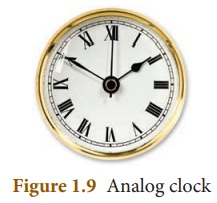
(1) Hours Hand : It is short and thick. It shows ‘hour’.
(2) Minutes Hand : It is long and thin. It shows ‘minute’.
(3) Seconds Hand : It is long and very thin. It shows ‘second’. It makes one rotation in one minute and 60 rotations in one hour.
Analog clocks can be driven either mechanically or electronically.
(ii) Digital clocks :
(1) A digital clock displays the time directly. It show’s the time in numerals or other symbols. It may have a 12 hours or 24 hours display.
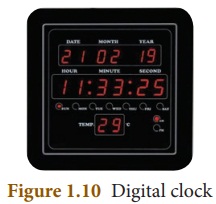
(2) Recent clocks are showing Date, Day, Month, Year, Temperature etc.
(3) Digital clocks are often called as Electronic Clocks.
Different types of clocks based on working mechanism :
(i) Quartz Clock:
(1) These clocks are activated by ‘electronic oscillations’, which are controlled by a ‘quartz crystal’.

(2) The frequency of a vibrating crystal is very precise. So, the quartz clock is more accurate than the mechanical clock.
(3) These clocks have an accuracy of one second in every 109 seconds.
(ii) Atomic Clock:
(1) These clocks are making use of periodic vibrations occurring within the atom.
(2) These clocks have an accuracy of one second in every 1013 seconds.

(3) Atomic clocks are used in Global Positioning System (GPS), Global Navigation Satellite System (GLONASS) and International time distribution services.
IX Higher Order Thinking Question.
1. Your friend was absent to school yesterday. You are enquiring about his absence. He told that he had fever and it was measured to be 100°C. Is it possible to have 100°C fever? If he is wrong, try to make him understand.
Answer: (i) No. It is not possible of 100°C fever. The normal temperature of human body is between 98.4°F and 98.6°F.
(ii) So, he should say that, he was affected by a fever of 100°F and it is not 100°C.
Numerical problems
Problem 1
If 2 coulomb of charge flows through a circuit for 10 seconds, calculate the current.
Solution
Charge (Q) = 2 C; Time (t) = 10 s
I = Q/t = 2/10 = 0.2 A
Problem 2
Convert 60° into radian.
Solution
We know that,
1° = π/180
60° = π/180 × 60 = π/3 radian
Problem 3
Convert π/4 into degrees.
Solution
We know that,
π radian = 180°
π/4 radian = 180/4 = 45°
Problem 4
Round off the number 1. 864 to two decimal places.
Solution
We need to round off the number to two decimal places. So, the last digit to be kept is 6. Since the next digit is less than 5, we can retain 6 as it is. So the answer is 1. 86.
Problem 5
Round off the number 1. 868 to two decimal places.
Solution
We need to round off the number to two decimal places. So, the last digit to be kept is 6. Since the next digit is more than 5, we should increase the second digit by one. So, the answer is 1. 87.
Student Activities
Activity 1
Measure the length and breadth of your science book using a ruler (scale) and 8 compare your value with those of your friends.
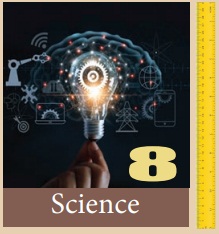
Students arc asked to measure the length and breadth of their science book using a ruler (scale) and compare their measurement with those of their friends.
Answer:
Aim : To determine the length and breadth of science book and to understand magnitude and unit.
Apparatus required: Science book and ruler (scale)
Tabular column:
Name of the object : Science textbook
Length (cm) : 25
Breadth (cm) : 21
Inference :
The length of science book l = 25 cm
The breath of science book b = 21 cm
Here, 25, 21 is the magnitude (number value) cm is the unit.
ACTIVITY
Measure the room temperature inside the class room and outside the class room by using a thermometer and tabulate it with different time intervals for a week. Do you find any differences in these values? Discuss your observations.
Answer:
Aim : To measure the room temperature inside the class room and outside the class room at different time intervals for a week.
Materials required : Thermometer.
Procedure :
(i) With the help of a thermometer, note down the room temperature inside and outside the class room at different time intervals of a day.
(ii) Repeat the process for 5 days.
(iii) Note down the temperature in the tabular column.

Inference:
(i) Temperature varies at different time intervals.
(ii) It varies from place to place.
Activity 2
From the news paper or television, collect the highest and lowest temperature experienced in your nearest town or city for a week and record the values in a tabular column. Does this data remain same throughout the year?
Collect the highest and lowest temperature details of your nearest town or city from the news paper or television for a week and record the values in a tabular column. Does this data remain same throughout the year?
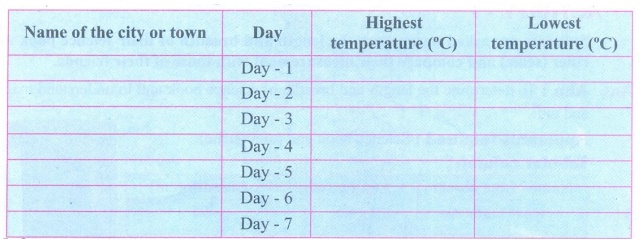
Inference: The data (temperature) does not remain same throughout the week.
Activity 3
Connect a battery, an ammeter and a lamp in series as shown in the figure. Note the ammeter reading. It is the amount of current flowing in the circuit.
Measure the current in an electric circuit.

Answer:
Aim: To measure the current in an electric circuit.
Components required: Battery, Ammeter and Lamp (Bulb).
Procedure :
(i) Connect the battery, ammeter and the lamp in series as shown in the figure.
(ii) Note the ammeter reading.
(iii) It is the current in the circuit.
Inference: Current is measured by using ammeter in an electric circuit.
ACTIVITY
Observe the ‘Rasam making’ process in your home. Ask your elders and try to answer the following questions:
(i) The rasam is made for how many persons?
(ii) How could you increase the taste?
(iii) How much of salt has to be added?
(iv) Is there any prescribed standard for taking the ingredients?
Answer:
(i) 4 persons.
(ii) By adding pepper, jeera and coriander leaves.
(iii) Approximately one and half table spoon.
(iv) No, there is no prescribed standard for taking the ingredients. While we prepare a dish, the ingredients are taken approximately.
Info bits
Luminous flux or Luminous power is the measure of the perceived power of light. Its SI unit is ‘lumen’.One lumen is defined as the luminous flux of the light produced by the light source that emits one candela of luminous intensity over a solid angle of one steradian.
Activity 4
Make a model of an analog clock using card board.
Activity 5
Make a model of a digital clock using match sticks on a card board, with date and time.
Activity 6
You may have heard about the ‘Sun Dial’. Construct a sundial of your own and read out the values from morning to evening. Compare your values with modern clocks.
Greenwich Mean Time (GMT)
is the mean solar time at the Royal Observatory, located at Greenwich in London. It is measured at the longitude of zero degree.The Earth is divided into 24 zones, each of a width of 15 degree longitude. These regions are called as ‘Time Zones’. Time difference between two adjacent time zones is 1 hour.
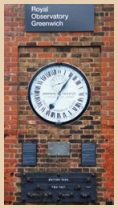
Indian Standard Time (IST)
The location of Mirzapur in Uttar Pradesh is taken as the reference longitude of the Indian Standard Time. It is located at 82. 5 degree longitude. IST = GMT + 5:30 hours
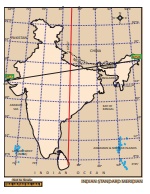
Activity
Calculate the approximate ‘heart beat’ of a man in a day (Hint: Take number of heart beats per minute as 75, approximately).
Calculate the approximate ‘heart beat’ of a man in a day. (Hint: Take number of heart beats per minute as 75, approximately)
Solution :
Number of heart beats per minute = 75 (approx.)
Approximate heart beat of a man in a day = ?
1 hour = 60 minutes
1 day = 24 hours
= 75 × 24 × 60
Approximate heart beat of a man in a day = 1,08,000














